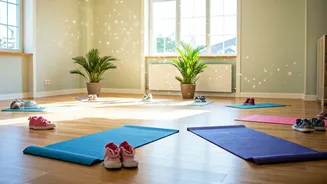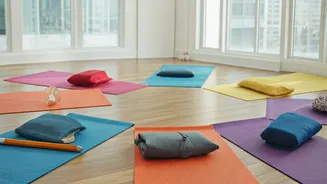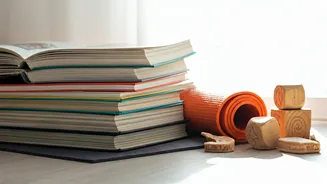Yoga's Brain Boost
Yoga, a practice rooted in ancient traditions, offers a plethora of benefits, and its positive impact on the cognitive abilities of children is increasingly
recognized. Integrating specific yoga asanas into a child's daily routine can significantly enhance their memory, focus, and overall mental clarity. The effectiveness of yoga stems from its ability to calm the nervous system, reduce stress, and improve blood flow to the brain. This enhanced blood flow delivers essential nutrients and oxygen, fostering better cognitive function. Moreover, yoga encourages mindfulness and body awareness, which contributes to improved concentration and attention span. Through these practices, children can cultivate a heightened sense of self-regulation and develop the capacity to manage distractions more effectively, ultimately leading to improved learning outcomes and academic performance. This article will provide the ten beneficial kid-friendly asanas that helps with memory and concentration.
Mountain Pose (Tadasana)
Tadasana, or Mountain Pose, is a foundational yoga pose that serves as a starting point for many other asanas. In this pose, the child stands tall with their feet firmly planted on the ground, mirroring the steadiness and strength of a mountain. The child should stand with their feet together or slightly apart, keeping their arms relaxed at their sides. They should engage their core muscles, maintaining a straight spine, and drawing their shoulders back and down. This posture cultivates a sense of grounding and stability, which in turn enhances concentration and focus. The act of standing still, while maintaining awareness of their body and breath, helps children develop self-control and presence of mind. To make it engaging for kids, parents or educators can encourage children to imagine themselves as tall, strong mountains, resisting the winds of distractions and remaining steadfast in their focus.
Tree Pose (Vrksasana)
Vrksasana, or Tree Pose, is a balance-challenging posture that fosters concentration and bodily awareness. The child starts by standing in Tadasana, then shifts their weight onto one leg. They then place the sole of the other foot either on the inner thigh or calf of the standing leg, avoiding the knee. Arms are raised overhead in a gesture resembling tree branches. Tree Pose encourages children to focus intensely on maintaining their balance. They should fix their gaze on a stationary point to help steady themselves. This pose improves their ability to stay calm and focused under pressure. It also strengthens the legs and improves overall body coordination. Educators can introduce this pose by encouraging children to imagine themselves as trees, swaying gently in the breeze. This visualization helps them feel more connected to the pose and increases their engagement. Practicing Vrksasana regularly can significantly improve a child's ability to concentrate and stay present.
Warrior II (Virabhadrasana II)
Virabhadrasana II, or Warrior II, is a dynamic pose that builds strength and resilience while promoting focus. In this stance, the child stands with their feet wide apart, turning one foot out 90 degrees and the other slightly inward. They bend the front knee to a 90-degree angle, ensuring the knee is over the ankle. Arms are extended to the sides, parallel to the ground, with the gaze focused over the front hand. This posture enhances both physical and mental strength by requiring a significant level of engagement in the legs and core. The alignment of the body and the focused gaze improves coordination and concentration. The act of holding the pose encourages children to remain steadfast despite any physical challenges or mental distractions. Teachers can make it more fun by encouraging children to channel their inner warriors, imagining themselves as brave and courageous individuals ready to face any challenge, helping them develop a sense of self-assurance and enhanced focus.
Triangle Pose (Trikonasana)
Trikonasana, or Triangle Pose, involves a combination of balance, stretching, and focus. The child starts with their feet wide apart, turning one foot out and the other slightly inward. They then reach one arm down towards the foot, while the other arm extends towards the ceiling. The gaze is directed upward, encouraging them to maintain their balance. This pose stretches the side body and strengthens the legs, while requiring a strong sense of balance and concentration. The need to maintain alignment and focus the gaze fosters mental clarity and helps children improve their ability to remain present. Educators can use this opportunity to discuss the importance of balance in everyday life, connecting the physical pose with mental and emotional balance. This reinforces the idea that maintaining equilibrium in their lives helps them to focus and concentrate more efficiently.
Downward Dog (Adho Mukha Svanasana)
Adho Mukha Svanasana, or Downward-Facing Dog, is an invigorating pose that can improve blood circulation to the brain, enhancing focus and memory. The child positions themselves on their hands and feet, forming an inverted 'V' shape with their body. They should focus on lengthening the spine and lifting their hips towards the ceiling, while keeping their head relaxed between their arms. This pose stretches the entire body and increases blood flow to the brain, which in turn boosts cognitive function. The controlled breathing involved helps to calm the mind and reduce stress, making it easier for children to concentrate. Teachers can incorporate this pose into a fun activity, like mimicking a dog stretching after a nap. This helps children connect with the pose and encourages relaxation and mental clarity, which are essential for improving memory and concentration.
Cobra Pose (Bhujangasana)
Bhujangasana, or Cobra Pose, is a gentle backbend that opens the chest and stimulates the mind. The child lies on their stomach with their hands placed under their shoulders. They lift their chest off the ground while keeping the lower body grounded, mimicking a cobra. This pose energizes the body and promotes a feeling of alertness. It gently stretches the spine, improving posture, and encouraging deeper breathing. The enhanced oxygen flow to the brain improves mental clarity and focus. Educators can guide children by encouraging them to imagine themselves as cobras, rising with strength and grace. This imaginative element enhances engagement and makes the pose more enjoyable, which increases the likelihood of consistent practice. Regular practice of Cobra Pose can help children improve their focus and memory by calming their minds and increasing mental clarity.
Bridge Pose (Setu Bandhasana)
Setu Bandhasana, or Bridge Pose, is a gentle backbend that strengthens the back muscles and stimulates the brain. The child lies on their back with knees bent and feet flat on the floor, close to their hips. They lift their hips off the ground, forming a bridge with their body, supporting themselves with their shoulders and feet. This posture improves blood circulation, particularly to the brain, and reduces stress. The lifting motion and focus required strengthens the mind-body connection, increasing focus and concentration. This pose also improves spinal flexibility, which can contribute to better posture and overall well-being. Teachers can introduce this pose by encouraging children to imagine they are building a bridge over a river. This activity fosters an imaginative and engaging learning environment, making the pose more fun, which can encourage children to keep practicing.
Child's Pose (Balasana)
Balasana, or Child's Pose, is a restful posture that offers a moment of calm and introspection. The child kneels with their knees together (or slightly apart) and bends forward, resting their torso on their thighs. They stretch their arms forward or place them alongside their body, and rest their forehead on the floor. This pose is a restorative posture that can help reduce stress and anxiety, promoting relaxation and mental clarity. It encourages deep, calming breaths, which helps in focusing the mind. This pose allows children to disconnect from external distractions and focus on their inner selves. Teachers can incorporate Child's Pose at the beginning or end of a yoga session, as a calming and centering exercise. This creates a peaceful transition for children, supporting their ability to manage stress and improve their concentration by setting a tranquil foundation.
Butterfly Pose (Baddha Konasana)
Baddha Konasana, or Butterfly Pose, is a seated forward bend that is beneficial for calming the mind and improving focus. The child sits with the soles of their feet together, knees bent and out to the sides. They hold their feet with their hands and gently flap their knees up and down, like the wings of a butterfly. This posture encourages relaxation and improves blood circulation. The gentle movement helps release tension in the hips and inner thighs, which contributes to a feeling of calm and reduces stress. Regular practice can enhance concentration by promoting a sense of inner peace. Teachers can encourage children to imagine they are butterflies, soaring through the sky with effortless grace. This visualization can make the pose more engaging and enjoyable, encouraging the children to concentrate better and relax more deeply, enhancing its benefits for their memory and concentration.











